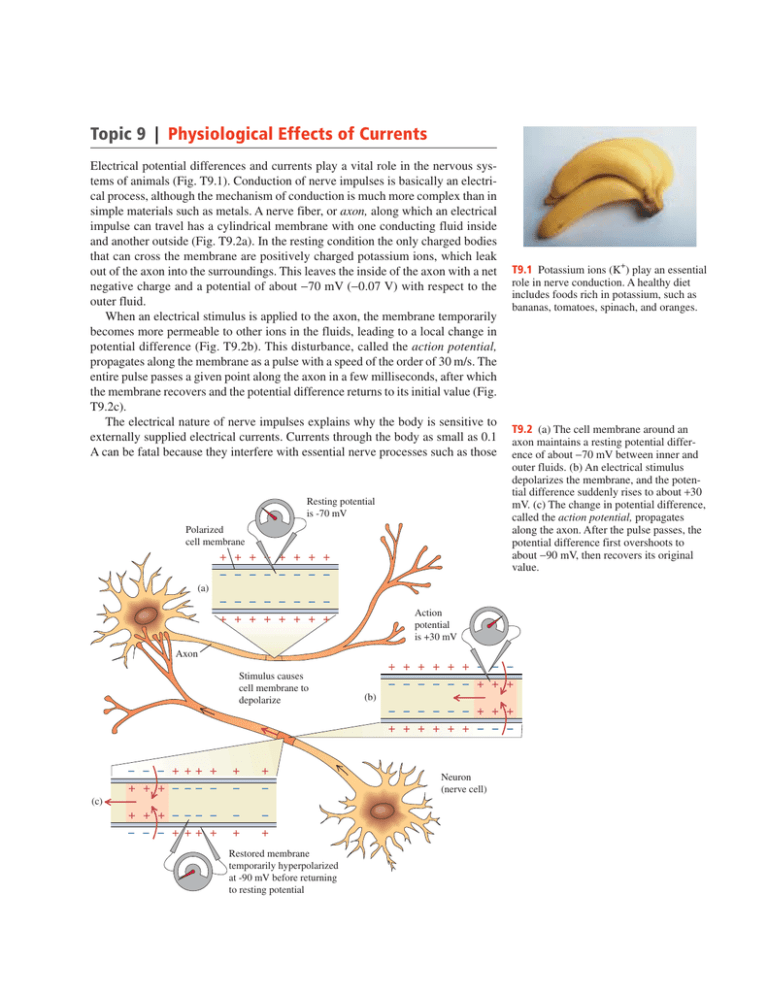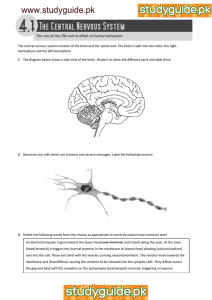Topic 9 | Physiological Effects of Currents
advertisement

Topic 9 | Physiological Effects of Currents Electrical potential differences and currents play a vital role in the nervous systems of animals (Fig. T9.1). Conduction of nerve impulses is basically an electrical process, although the mechanism of conduction is much more complex than in simple materials such as metals. A nerve fiber, or axon, along which an electrical impulse can travel has a cylindrical membrane with one conducting fluid inside and another outside (Fig. T9.2a). In the resting condition the only charged bodies that can cross the membrane are positively charged potassium ions, which leak out of the axon into the surroundings. This leaves the inside of the axon with a net negative charge and a potential of about −70 mV (−0.07 V) with respect to the outer fluid. When an electrical stimulus is applied to the axon, the membrane temporarily becomes more permeable to other ions in the fluids, leading to a local change in potential difference (Fig. T9.2b). This disturbance, called the action potential, propagates along the membrane as a pulse with a speed of the order of 30 m/s. The entire pulse passes a given point along the axon in a few milliseconds, after which the membrane recovers and the potential difference returns to its initial value (Fig. T9.2c). The electrical nature of nerve impulses explains why the body is sensitive to externally supplied electrical currents. Currents through the body as small as 0.1 A can be fatal because they interfere with essential nerve processes such as those Resting potential is -70 mV Polarized cell membrane ⴙ ⴙ ⴙ ⴙ ⴙ ⴙ ⴙ ⴙ ⴚ ⴚ ⴚ ⴚ ⴚ ⴚ ⴚ ⴚ T9.1 Potassium ions (K+) play an essential role in nerve conduction. A healthy diet includes foods rich in potassium, such as bananas, tomatoes, spinach, and oranges. T9.2 (a) The cell membrane around an axon maintains a resting potential difference of about −70 mV between inner and outer fluids. (b) An electrical stimulus depolarizes the membrane, and the potential difference suddenly rises to about +30 mV. (c) The change in potential difference, called the action potential, propagates along the axon. After the pulse passes, the potential difference first overshoots to about −90 mV, then recovers its original value. (a) ⴚ ⴚ ⴚ ⴚ ⴚ ⴚ ⴚ ⴚ Action potential is +30 mV ⴙ ⴙ ⴙ ⴙ ⴙ ⴙ ⴙ ⴙ Axon Stimulus causes cell membrane to depolarize ⴙ ⴙ ⴙ ⴙ ⴙ ⴙ ⴚ ⴚ ⴚ ⴚ ⴚ ⴚ ⴚ ⴚ ⴚ ⴙ ⴙ ⴙ (b) ⴚ ⴚ ⴚ ⴚ ⴚ ⴚ ⴙ ⴙ ⴙ ⴙ ⴙ ⴙ ⴙ ⴙ ⴙ ⴚ ⴚ ⴚ ⴚ ⴚ ⴚ ⴙ ⴙⴙ ⴙ ⴙ ⴙ ⴙ ⴙ ⴙ ⴚ ⴚⴚ ⴚ ⴚ ⴚ ⴙ ⴙ ⴙ ⴚ ⴚⴚ ⴚ ⴚ ⴚ ⴚ ⴚ ⴚ ⴙ ⴙⴙ ⴙ ⴙ ⴙ (c) Restored membrane temporarily hyperpolarized at -90 mV before returning to resting potential Neuron (nerve cell) in the heart. Even smaller currents can also be very dangerous. A current of 0.01 A through an arm or leg causes strong, convulsive muscle action and considerable pain; with a current of 0.02 A, a person holding the conductor that is inflicting the shock is typically unable to release it. Currents of this magnitude through the chest can cause ventricular fibrillation, a disorganized twitching of heart muscles that pumps very little blood. Surprisingly, very large currents (over 0.1 A) are somewhat less likely to cause fatal fibrillation because the heart muscle is “clamped” in one position. The heart actually stops beating and is more likely to resume normal beating when the current is removed. The electric defibrillators used for medical emergencies apply a large current pulse to stop the heart (and the fibrillation) to give the heart a chance to restore normal rhythm. Body fluids are usually quite good conductors because of their substantial ion concentrations. By comparison the resistance of skin is relatively high, ranging from 500 kΩ for very dry skin to 1000 Ω or so for wet skin, depending also on the area of contact. If R = 1000 Ω, a current of 0.1 A requires a potential difference of V = IR = (0.1 A)(1000 Ω) = 100 V. Were it not for the high resistance of skin, even an ordinary 1.5-V flashlight battery could produce a hazardous shock. In summary, electric current poses three different kinds of hazards: Interference with the nervous system, injury caused by convulsive muscle action, and burns from I2R heating. The moral of this rather morbid story is that under certain conditions, voltages as small as 10 V can be dangerous. All electrical circuits and electrical equipment should always be approached with respect and caution. On the positive side, alternating currents with frequencies of the order of 106 Hz do not interfere appreciably with nerve processes and can be used for therapeutic heating for arthritic conditions, sinusitis, and other disorders. If one electrode is made very small, the resulting concentrated heating can be used for local destruction of tissue such as tumors or for cutting tissue in certain surgical procedures. The study of particular nerve impulses is an important diagnostic tool in medicine. The most familiar examples are electrocardiography (EKG) and electroencephalography (EEG). Electrocardiograms, obtained by attaching electrodes to the chest and back and recording the regularly varying potential differences, are used to study heart function. Electrodes attached to the scalp permit study of potentials in the brain, and the resulting patterns can be helpful in diagnosing disorders such as epilepsy or brain tumors.
